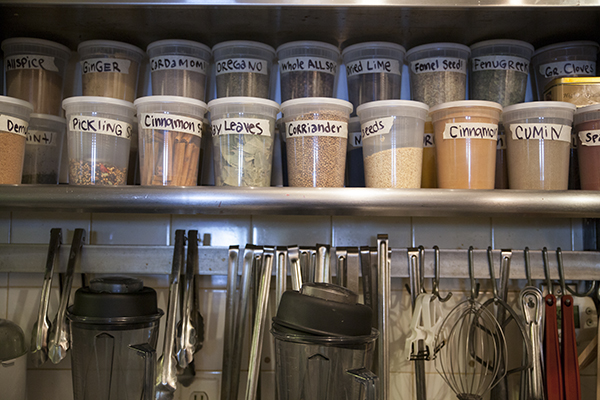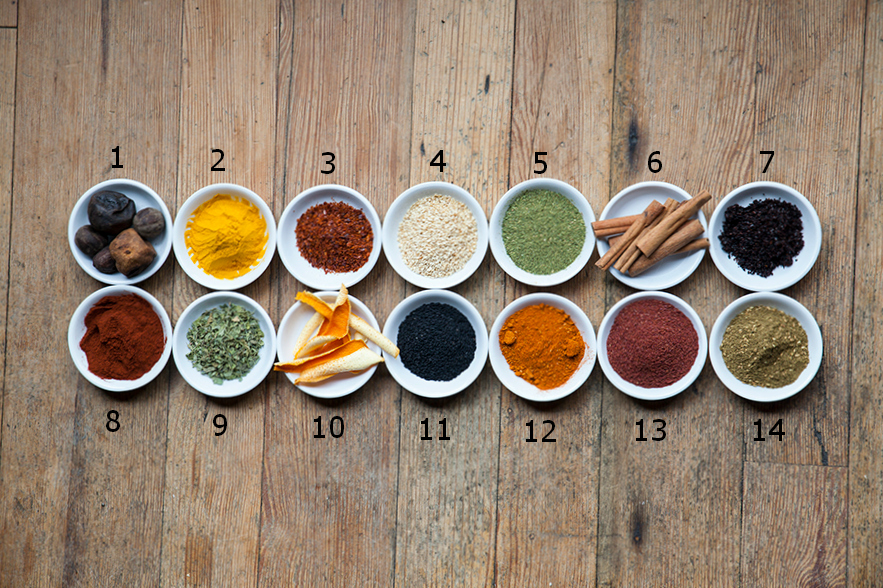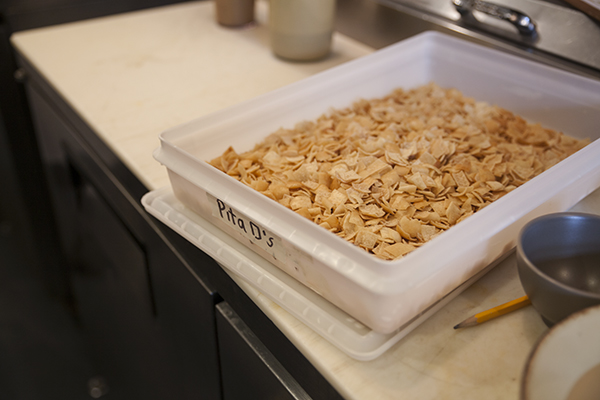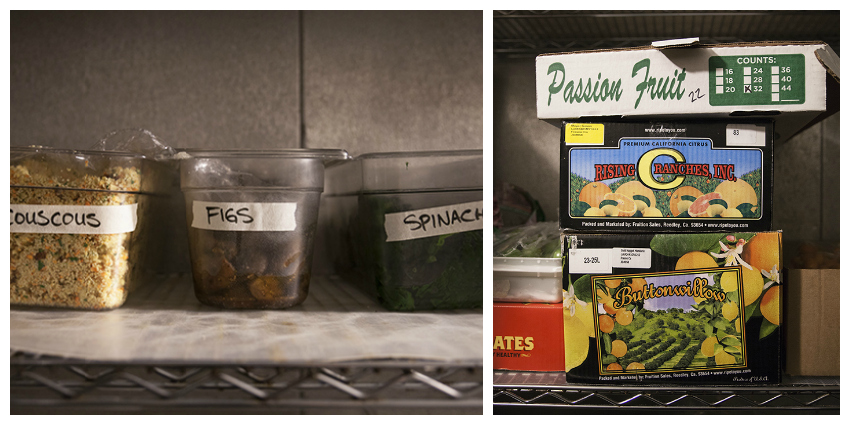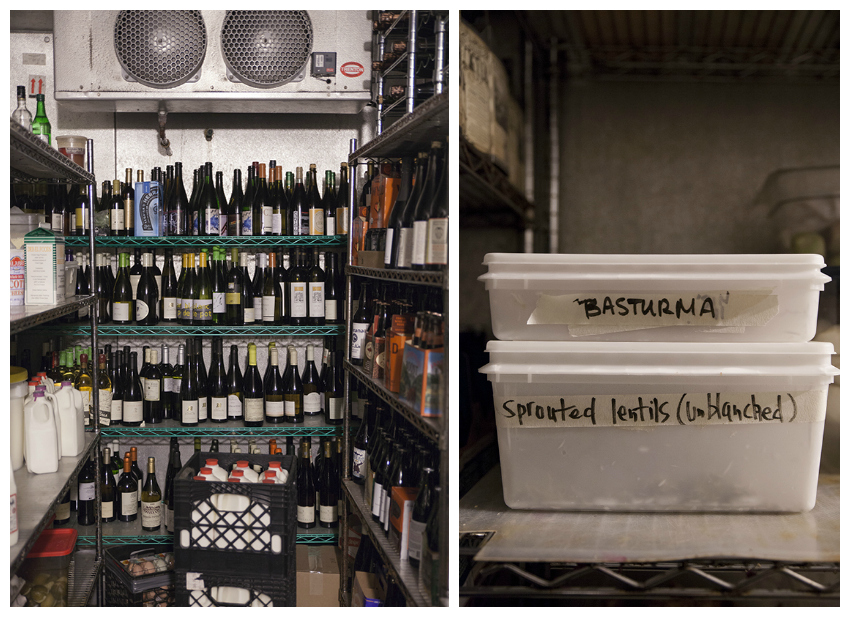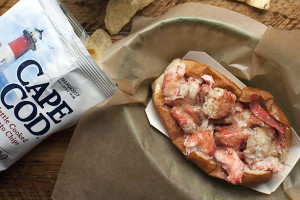Taking Inventory: The Spice-Filled Kitchen at Oleana
Welcome to Taking Inventory, where we raid the spice racks, walk-ins, bar shelves, and tool arsenals of the restaurants and artisans in the Boston area.
If you’ve had the pleasure of dining at Oleana, you’ve no doubt had your palate opened to a vast array of exotic spices and spice blends—from the za’atar that dusts the lemony flattened chicken, to the nigella seeds paired with the bread and cheese dumplings, to the crunchy dukkah sprinkled atop the carrot puree. And it’s because of these unique flavors and ingredients that Ana Sortun’s refined-yet-earthy, Middle East-inspired Cambridge restaurant remains one of the area’s most exciting dining destinations in the Boston area. While Sortun owns the restaurant and is at its helm, chef de cuisine Cassie Piuma (who has worked with Sortun for 11 years at Oleana) runs the day-to-day, sourcing ingredients and cataloging orders each shift.
Later this summer, Piuma will be operating on a bigger stage when she opens Sarma, a new mezze-focused Somerville restaurant that she’ll co-own with Sortun. Piuma promises a menu that will function almost like “Middle Eastern dim sum,” with a mix of small mezze dishes and large platters that servers will bring from table to table (like tabblouleh and fattoush salads, large racks of lamb) that diners can elect to partake in a helping of for an additional price. But while the menu format at Sarna will be different from its big sister, Oleana, Piuma promises that many of the ingredients and flavor profiles will remain the same. She talks us through the signature spices, grains, and produce that you’ll soon recognize at both restaurants ahead.
Above, a combination of Piuma’s favorite and most essential spices in the Oleana pantry.
1. Persian dried limes: “We re-hydrate them in soups, grind it down into a powder and season fish with it, or put it into our spice mixes. It’s acidic, but less acidic than a traditional lime or lemon, and less bitter. But it gives that sour acidity that you are looking for with citrus.”
2. Turmeric: “Turmeric has a lot of health benefits, and finds its way into a lot of spice blends.”
3. Marash chili pepper: “Those literally go on everything. Not only do they season food, but we garnish with them. If you order a puree or dip, you’ll find that as a garnish on top to give extra heat. They are sort of pleasantly hot and addictive.”
4. Sesame seeds: “Although they look really white in that picture, we always use really heavily toasted sesame seeds to bring out that oil in the seed and give it a rich, nutty flavor.”
5. Shabazi (spice blend):“This is one of the spices that we don’t make in house, we get them from a company called La Boîte á Epice. This one is basically the dried version of zhug, which is an Israeli hot sauce or a green harissa. It’s a spicier blend with lots of green herbs and chilies. So this guy in New York, Lior [Lev Sercarz] , who has this company, is a spice master and designs all these specialty blends. We currently use it with the quail appetizer. It’s good with poultry.”
6. Cinnamon sticks: “In addition to sweet things, we use it a lot in savory preparations. Moroccan food in general has a lot of cinnamon; that’s the number one spice used in that cuisine. We use it for the carrot soup, and we use fresh ground cinnamon in moussaka. Oftentimes we grind it fresh, or we just steep soups and sauces with the whole cinnamon stick.“
7. Urfa pepper: “It’s sort of a dark, really rich chocolate-y chile. It’s a little smokey. Urfa is something we use currently to garnish our smoked eggplant with pine nut puree.”
8. Smoked paprika: “We use different varieties of paprika. Paprika gets used a lot in our Spanish-inspired dishes. We have a pork empanada on the menu right now, and we use a lot of smoked paprika to braise the pork.”
9. Turkish dried mint: We brought that back from our last trip in Turkey. In Turkey, they have these incredible spice markets and they seek [herbs] out—they will travel to 4 or 5 different places just to get the right mint. This stuff is exceptional. It’s really bright and herbaceous, and super potent. We use that particular mint when we make our tzatziki.”
10. Dried orange peel: “We dehydrate these in our awesome dehydrator. We grind the orange peel down really fine, and we mix it into aioli. That flavors our spicy fideos with chickpeas, which is a Spanish-style pasta dish.”
11. Nigella seeds: “They kind of have an onion-y flavor to them. We garnish our Armenian string cheese with nigella seeds. The person who makes it for us, Fiore di Nonno in Somerville, incorporates the nigella into it.”
12. Dali (spice blend): “Another spice mix from Lior in New York. The funny thing is, his spice mixes are so top-secret that we don’t really know all the ingredients he puts in them. He gives us clues. That one, I think, is a mixture of chili and saffron, we think maybe some tomato. We use it to spice pork belly right now on the menu. It’s a good one for meat.”
13. Sumac: “Sumac is a really acidic, and mimics a lemony flavor. We use it a lot in dressings and salads. It’s the number one important ingredient in the fattoush salad. That gets dressed with pomegranate molasses, olive oil, and lots of sumac. It makes fresh vegetables pop, because it has this bright acidity to it.”
14. Za’atar: “This is the most important. It’s thyme and oregano mixed with sesame seeds and sumac. When you go to the Middle East, they are really intense about it, and people will design their za’atar to their liking. It tastes different from region to region, depending on where the oregano or wild thyme is grown. We use that on our flattened chicken. We smear the chicken with a thick paste of za’atar and olive oil when it comes off the grill.”
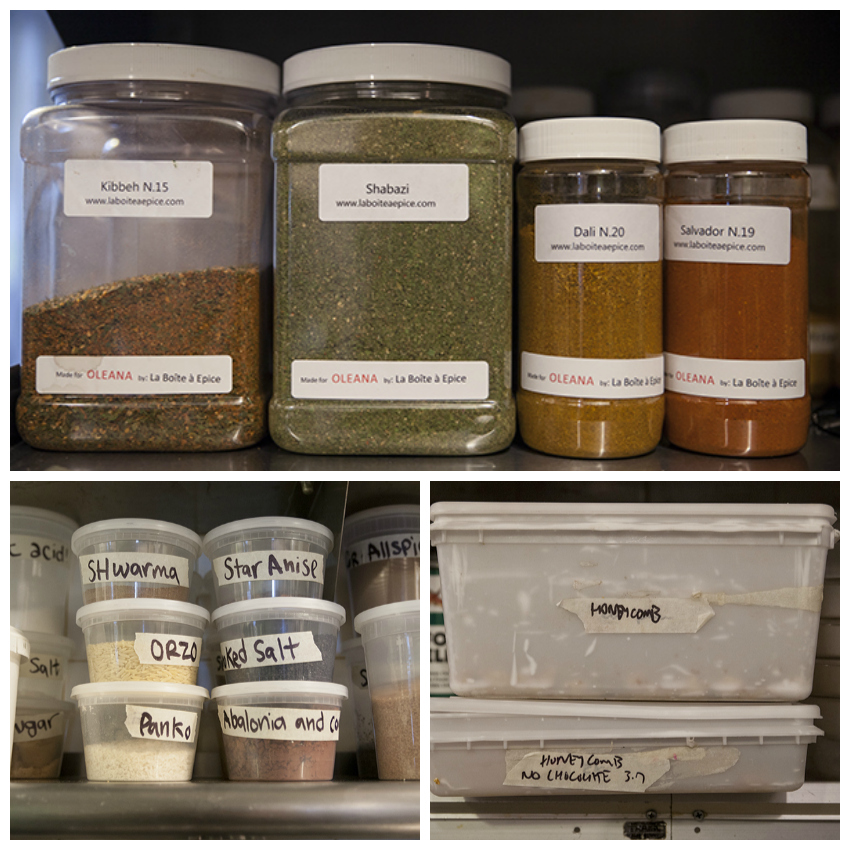
Clockwise from top:
1. “We have an arsenal of spices. It’s very unusual. We are very particular about going through and grinding them in a rapid way. We never let them sit ground for very long. They lose their potency as they sit,” Piuma says. Piuma and her team gets most of their spices in whole (often from Christina’s in nearby Inman Square) and grinds them by hand. Some spices, like those pictured at top, are custom blends from La Boîte á Epice. “Some of those spices he made were designed specifically for us,” Piuma says. “Then the spices become part of his line, and available to everyone. We sell his whole spice line in small, home-sized containers at Sofra.”
2. Honeycomb, which pastry chef Maura Kilpatrick utilizes for desserts. “Maura makes an aleppo honeycomb in-house, using aleppo chilies. Then she works with Taza Chocolate in Somerville, and they turn her aleppo honeycomb into a candy bar, basically. It comes back to Maura, and she takes it from there,” Piuma says.
3. More specialty spices and ingredients. Of note: appolonia (a cocoa nib and orange blend from La Boîte á Epice); smoked salt (used to impart smokiness into the mezze plate of whipped feta); citric acid (used often in Middle Eastern cuisine to preserve color and add an acidic zip in place of citrus); shawarma spice (another custom spice blend used for braising lamb and chicken); panko crumbs (used to create a lighter crust when deep-frying).
Homemade pita chips, used for the fattoush salad. “We take fresh pita, cut it into small squares, and then deep-fry it and season it with a little bit of salt,” Piuma says.
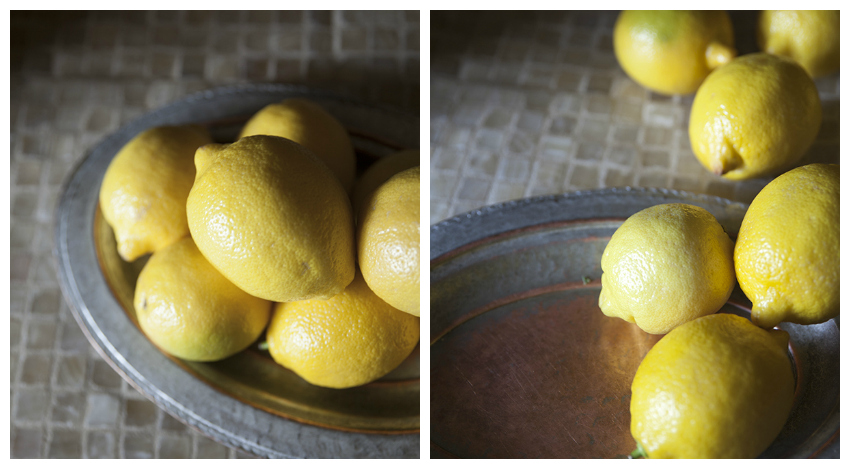 Lemons: “They are sort of the pulse of Middle Eastern food,” Piuma says. “If I had to pick a number one ingredient that I couldn’t live without, it’s lemon. During the season, when available, we use meyer lemon for a lot of things. It’s smaller, sweeter, and a little more floral. We go through a case every two days
Lemons: “They are sort of the pulse of Middle Eastern food,” Piuma says. “If I had to pick a number one ingredient that I couldn’t live without, it’s lemon. During the season, when available, we use meyer lemon for a lot of things. It’s smaller, sweeter, and a little more floral. We go through a case every two days
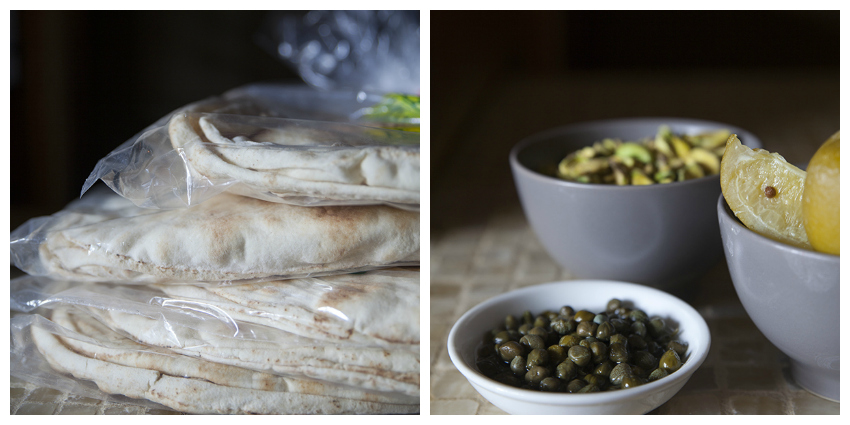 Left: Oleana sources pita from several purveyors, including Sevan Bakery in Watertown. Right: 1. Capers (foreground): “We use brined capers or salt-packed capers,” Piuma says. “The salt-packed ones are great, but can be very intense. Brined capers are less in-your-face, and still delicious. We make a lot of dressing with capers, and we also make a Tunisian caper sauce.” 2. Pistachios (background): “These are used widely all over the menu,” Piuma says. “We grind them up really fine, and use them as a coating for our quail.” 3. Preserved lemon (right): “We make housemade preserved lemons. They’re in salt for two and a half months, and then we remove the pith and seeds and use the skin. We try to use meyer lemons, since they have a thinner skin,” Piuma says. “We use the zest in almost everything, and make a lemon vinaigrette which dresses lots of the salads.”
Left: Oleana sources pita from several purveyors, including Sevan Bakery in Watertown. Right: 1. Capers (foreground): “We use brined capers or salt-packed capers,” Piuma says. “The salt-packed ones are great, but can be very intense. Brined capers are less in-your-face, and still delicious. We make a lot of dressing with capers, and we also make a Tunisian caper sauce.” 2. Pistachios (background): “These are used widely all over the menu,” Piuma says. “We grind them up really fine, and use them as a coating for our quail.” 3. Preserved lemon (right): “We make housemade preserved lemons. They’re in salt for two and a half months, and then we remove the pith and seeds and use the skin. We try to use meyer lemons, since they have a thinner skin,” Piuma says. “We use the zest in almost everything, and make a lemon vinaigrette which dresses lots of the salads.”
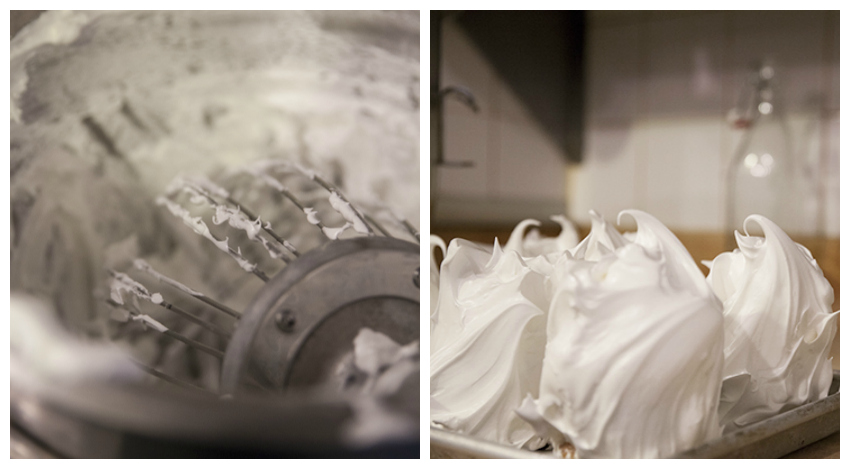 Above, the makings of the restaurant’s signature Baked Alaska. “I would say it’s definitely the iconic dessert at Oleana. It will never leave the menu,” Piuma says. “It’s a coconut macaroon cake topped with toasted coconut ice cream, and then the pastry chefs do their magic to make a beautiful meringue top [ed’s note: there’s also passion fruit caramel. Oh yeah.]. We probably sell between 20 and 25 of them a night.”
Above, the makings of the restaurant’s signature Baked Alaska. “I would say it’s definitely the iconic dessert at Oleana. It will never leave the menu,” Piuma says. “It’s a coconut macaroon cake topped with toasted coconut ice cream, and then the pastry chefs do their magic to make a beautiful meringue top [ed’s note: there’s also passion fruit caramel. Oh yeah.]. We probably sell between 20 and 25 of them a night.”
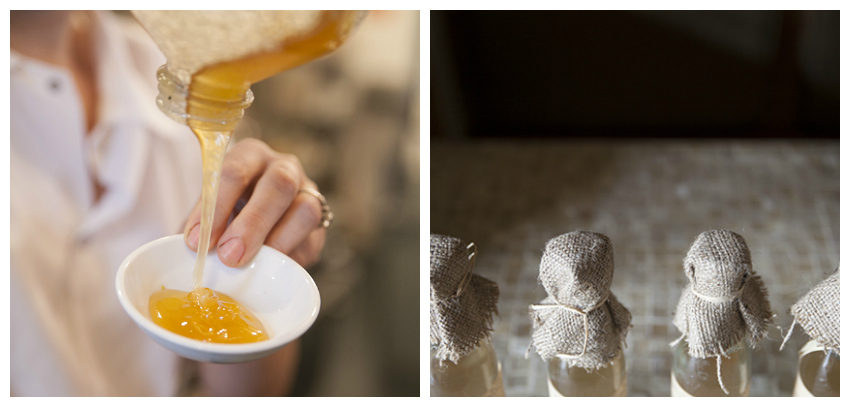 Left: “That’s a raw, unfiltered honey from Carlisle. It’s the main honey that we work with—if you order a Moroccan or Turkish tea, you’ll get Carlisle honey with that. It’s also one of the components in the Moroccan dressing that we put on our fluke. We sell small containers of it at Sofra.” Right: “That’s orange blossom water and rose water,” Piuma says. “We found a really great purveyor out of Lebanon, and they sell this at Sofra. In pastry, it’s used in the nougat glacee. The orange blossom water goes in savory Moroccan dishes.”
Left: “That’s a raw, unfiltered honey from Carlisle. It’s the main honey that we work with—if you order a Moroccan or Turkish tea, you’ll get Carlisle honey with that. It’s also one of the components in the Moroccan dressing that we put on our fluke. We sell small containers of it at Sofra.” Right: “That’s orange blossom water and rose water,” Piuma says. “We found a really great purveyor out of Lebanon, and they sell this at Sofra. In pastry, it’s used in the nougat glacee. The orange blossom water goes in savory Moroccan dishes.”
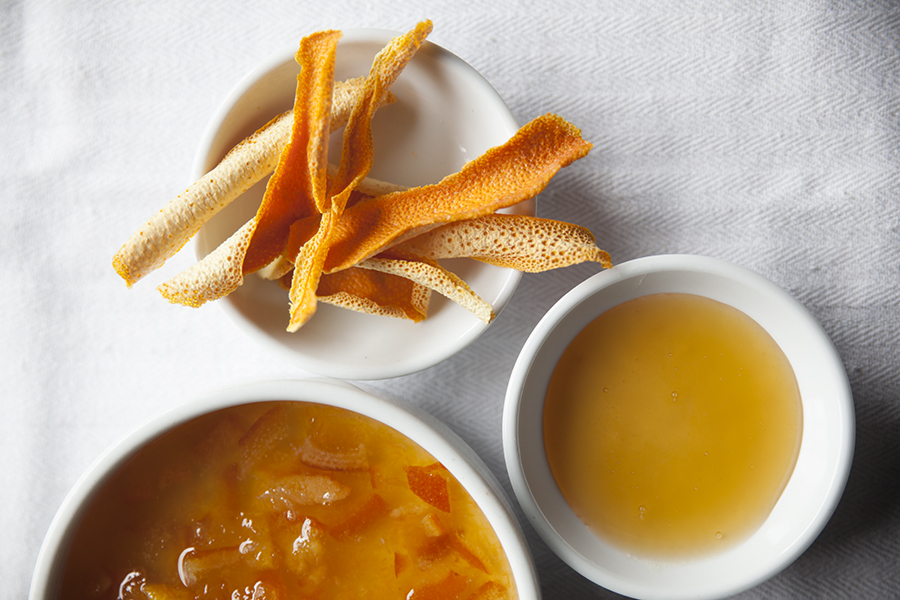
Left: Dried orange peel (top), Carlisle honey (right), and Turkish orange marmalade (front). “This is a really beautiful chunky orange marmalade that we get imported from Turkey,” Piuma says. Want some for yourself? Piuma says you can find it at Sevan in Watertown.
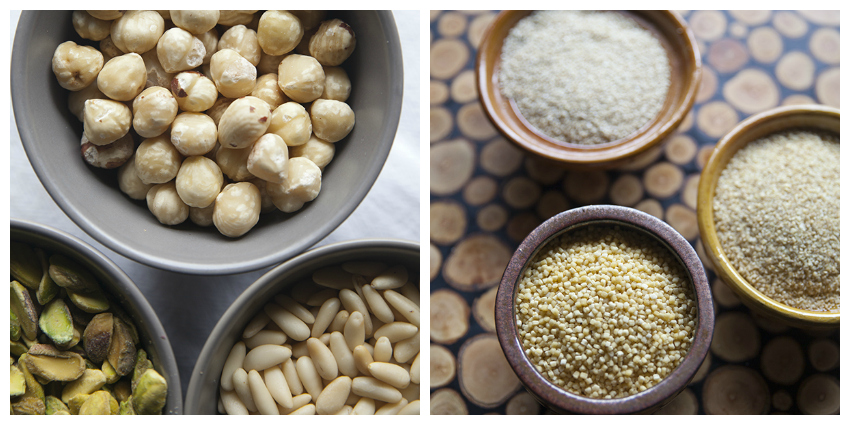 Left: “We specifically use Turkish pine nuts as opposed to Chinese pine nuts. It’s a pretty substantial difference,” Piuma says. “They are a lot richer, and more oily and buttery than Chinese ones.” As for the hazelnuts? “We get awesome toasted ones that are all shelled and ready to go. We grind them up fine, and use them as a component in our dukkah, an Egyptian spice mix that comes with our carrot puree.” Right: “The one in the front is trahana, and that’s a sour yogurt pasta,” Piuma says. “It’s used in Greek dishes. You could simmer it in a stew with braised meats, or you could make a yogurt soup and float some trahana in it.” At top left is fine-grain bulgur, which Oleana uses to make their tabbouleh. And at right is barley couscous, which the kitchen uses for carrot couscous (see below for more on that one).
Left: “We specifically use Turkish pine nuts as opposed to Chinese pine nuts. It’s a pretty substantial difference,” Piuma says. “They are a lot richer, and more oily and buttery than Chinese ones.” As for the hazelnuts? “We get awesome toasted ones that are all shelled and ready to go. We grind them up fine, and use them as a component in our dukkah, an Egyptian spice mix that comes with our carrot puree.” Right: “The one in the front is trahana, and that’s a sour yogurt pasta,” Piuma says. “It’s used in Greek dishes. You could simmer it in a stew with braised meats, or you could make a yogurt soup and float some trahana in it.” At top left is fine-grain bulgur, which Oleana uses to make their tabbouleh. And at right is barley couscous, which the kitchen uses for carrot couscous (see below for more on that one).
And now, we enter the walk-in. Left: At far left is the restaurant’s carrot couscous. “The barley has a lot more health benefits to it [than semolina couscous],” Piuma says. “We mix it with equal parts carrots that are ground to mimic the couscous, and then lots of Moroccan spices, toasted almonds, and herbs.” At middle, figs. “We are using beautiful figs from Greece right now. We simmer those figs with olive oil and dried oregano, and we serve them on our cheese plate.” At far right, blanched spinach that will eventually become Oleana’s famous spinach falafel. “Falafel is our number one seller. That one container of spinach is about a case-and-a-half worth of spinach, and we go through that every single day.”
Left: Just a snapshot of the extensive list of wines on offer at the restaurant. Right: “Basturma is an air-dried beef that is flavored with fenugreek, paprika, and cumin. It finds its way into a lot of stuff, but predominantly it’s used in the buttered hummus. We slice the basturma really thin as if you were slicing prosciutto, and then we wrap it around a scoop of Turkish-style buttered hummus and warm it up in the oven. Below the basturma is a tub of sprouted lentils. “It’s a fun new thing we are doing, where we are sprouting grains and legumes,” Piuma says. “You take a french grain lentil, soak it overnight, drain it on a sheet pan with a towel for like 5 days, and basically a little sprout pops out during this soaking process. It has a lot of nutritional value and allows you to absorb all the nutrients of the legume, and it’s a totally different flavor than eating a cooked green lentil.”
